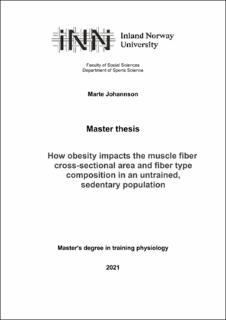How obesity impacts the muscle fiber cross-sectional area and fiber type composition in an untrained, sedentary population
Abstract
Introduction: Obese individuals possess excess adipose tissue interacting with the skeletal muscle, resulting in an alteration in the contractile properties of the muscle tissue resulting in reduced muscle quality and function.
Purpose of study: The aim of the study was to investigate how the degree of obesity impacted the muscle fiber type CSA and composition in an overweight sedentary population after a 10-week resistance training intervention.
Method: 29 men and women between 30-60 years of age were recruited and completed 10 weeks of 2 weekly supervised resistance training sessions. Biopsies and ultrasound of m. vastus lateralis, DXA scans and isokinetic knee extensor strength tests were conducted prior to supplementation period, prior to intervention period and after intervention period. Results were analysed in RStudio.
Results: The results indicated no significant increase in muscle fiber type CSA for type I nor II between the timepoints, but there was a significant increase in the intervention period in comparison with the control period of CSA for both fiber types. There was a significant increase in isokinetic strength and muscular growth measured as muscle thickness amongst the participants.
Conclusion:
Based on these findings there's reason to believe that in relation to individuals with a BMI within recommended values, the increased chronic inflammation due to obesity, in correlation with inactivity, leads to an increased muscle fiber type CSA, shift in fiber type composition with increased ratio of fiber type II as well as a reduction in relative muscle strength.
